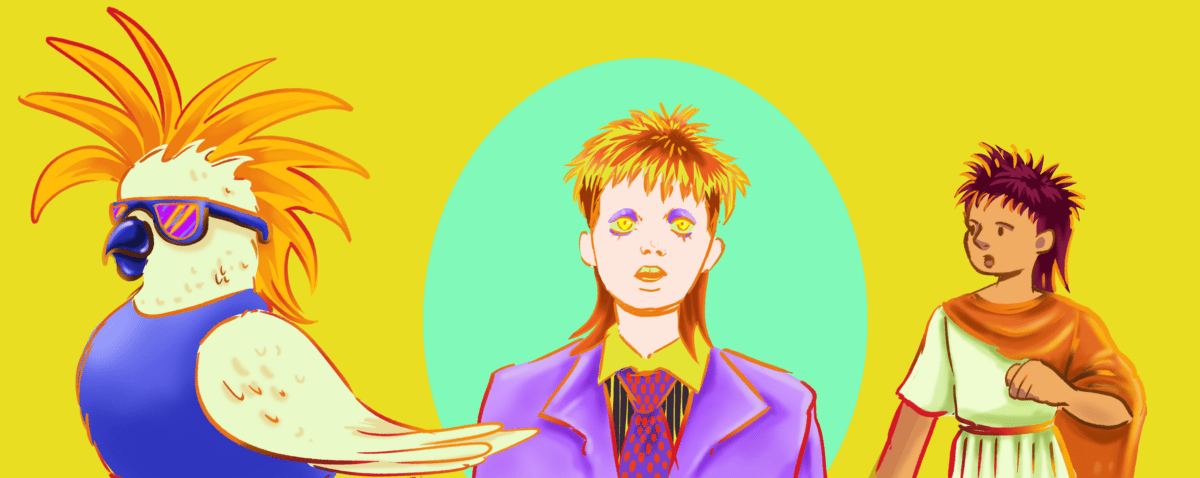BCE: An evolutionary need to keep vision unobscured while warming the neck and shoulders may mean that sporting a healthy mullet was simply human nature. Reports of this style crop up from prehistoric periods, to Ancient Roman pantheons.
The 1970s: The great resurrection. The modern mullet would be nothing without Goblin King and glam rock legend— David Bowie. Blurring the lines of masculinity and femininity, the brassy orange signature of Ziggy Stardust quickly shot the hairstyle into the public eye.
Honourable mentions: shaggy, feathered fringes as seen floating across the foreheads of Jane Fonda, Stevie Nicks, and Siouxsie Soux. Even with bangs covering their eyes, they had true vision – a fashion foresight that was set to last.
The 1980s: The golden era of mullets. With the economy booming, business was good. And so was the party. Mullets were being rocked unabashedly, on the heads of athletes, yuppies, rockers, and country singers alike. Mullet stocks were on the rise and rise. No longer just for the bohemian, the bi-length cut became cemented in mainstream vernacular. Rob Lowe and Patrick Swayze set teenage hearts ablaze with shoulder-skimming locks.
Down under, a certain Working Class Man fronted the movement for mullets amongst regular Aussie battlers. Jimmy Barnes defied OHS rules as well as traditional short-back-and-sides in his power ballad that came akin to a national anthem.
The mullet also found itself rooted in LGBT subcultures, where the style caught on in lesbian communities as a queer-coded fashion statement. Subverting the heteronormative male gaze, an unorthodox hairstyle was a way to subtly signal at one’s alternative identity.
The 1990s: The dark ages. The value of stocks and mullets suddenly crashed. The haircut became culturally bankrupt, derided, and maligned. All but Billy Ray Cyrus abandoned the look. Where before, this distinctive haircut marked unironic masculinity, pride, and a devil-may-care rejection of conservative fashions, it now fell on deaf ears. Negative stereotypes of US ‘rednecks’ and Aussie ‘bogans’ crashed their respective pickup trucks and utes right through the hallowed halls of iconic mullet history.
With mullets now adorning only the barbershop floor, it seemed the party may be over for good.
The 2000s: Radio silence. Beiber bowl cuts and emo swoops hinted at the edge of mullethood, but never quite carried off the same carefree charisma.
The 2010s: All quiet on the western front. High-maintenance styles – quiffs, precision undercuts, man buns – were all the rage. Mononymous-named icons Zendaya and Rihanna both debuted mullets on the red carpet during the mid-2010s, to little avail. However, a little further east, rumblings of a resurgence had begun to grow. The style made an occasional appearance in South Korean popular culture, with K-pop idols like Big Bang’s G-Dragon daring to pull off the controversial look.
The 2020s: The renaissance. Whether it be a renewed acceptance of fluid gender expression, a 1970s revival via mechanised trend cycles, or the genetic raw sex appeal of the Cyrus bloodline – the mullet is back, baby! Much to our parents’ collective horror, the new wave of high-low hairlines have millennials and Zoomers in a chokehold.
Private-school jocks à la Bailey Smith, and tote-bag-TikTok-twenty-somethings; once divided, now alike. There’s a 90% chance either you (or someone you know) has shown a picture of be-mulletted Billie Eilish to a hairdresser in the last 12 months.
And that’s without acknowledging the big bad unprecedented times that have loomed over our world since early 2020. When you’re stuck in the ever-revolving door of the pandemic, giving into shaggier styling seems the sensible thing to do.
Within the ANU community, the return of the mullet could mean many things.
For Jackson, it meant:
“Looking in the mirror and being confident. It means no more getting sunburnt on my neck, it means I can dress any way I want to, it means getting comments in public and from my friends. It means I may not get that job I’m going for but it also represents my personality perfectly and is a large part of who I am.”
Another student, Karolina, expressed that:
“Running with the most aerodynamic hairstyle that exists was the greatest joy I have ever experienced.”
For me, what started as a way for me to rehabilitate heat-damaged hair, also restored a damaged trust in natural femininity. So now I listen to Greta Van Fleet, and wear shoes a lot less.
For a lot of people, the draw of a mullet was probably a chance to have a bit of a laugh in admittedly dim times. Post-ironic or not, there is something magical about gathering around the kitchen table armed with overgrown hair, kitchen scissors, and a dream.
Originally published in Woroni Vol.72 Issue 1 ‘Evolution’
We acknowledge the Ngunnawal and Ngambri people, who are the Traditional Custodians of the land on which Woroni, Woroni Radio and Woroni TV are created, edited, published, printed and distributed. We pay our respects to Elders past and present. We acknowledge that the name Woroni was taken from the Wadi Wadi Nation without permission, and we are striving to do better for future reconciliation.
